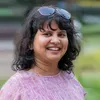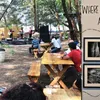Imagine, question, collaborate – curator insights on creativity from Serendipity Arts Festival 2019
In a range of conversations, curators of Serendipity Arts Festival 2019, Goa, share their views on the importance of diversity, heritage, modernity, technology, and real-world experiences.
The Serendipity Arts Festival (SAF) kicks off from December 15 to 22 in Panaji, Goa. The cross-cutting programme covers the visual, performing and culinary arts, as well as film, literature, and fashion.

In our earlier interview with Smriti Rajgarhia, Director, Serendipity Arts Foundation, we shared perspectives on the role of art and design in society, and how the art festival is shaping up this year (see full-length interview here).
Curators of six projects at SAF 2019 now join us in a series of conversations: Work in Progress (Sudarshan Shetty), Virtuality as Reality (Jessica Castex and Odile Burluraux), Alternative Histories of Indian Art (Nancy Adajania), Ceramics for Living Sustainable Craft (Kristine Michael), and Goa Familia (Lina Vincent).
Sudarshan Shetty
“The project Work in Progress started with my long-time interest in indigenous innovations that are essentially reliant on local know-how and technologies,” Sudarshan explains, in a chat with YourStory. The project also includes how ideas are communicated in communities, including channels like songs and poetry.
Featured exhibits include a zero-energy coolant developed by Ant Studio (modeled like a beehive), and even a stampede-detection mat designed by Nilay Kulkarni. Sudarshan observes that Indian innovators have lots of potential, but many of their ideas need to be brought into the mainstream marketplace.
“SAF is the only multi-arts festival of its kind in India. The festival encourages the coming together of various arts with an open agenda on collaborations between artists and curators,” Sudarshan highlights.

Kristine Michael
A unique exhibition at SAF 2019 discusses artistic modernism in contemporary ceramic and glass in India. It re-imagines past traditions via design collaboration between craft cluster communities, explains curator Kristine Michael. The focus is on sustainability, enhancing creativity, and economic independence.
She cites the work of Russian art theorist Kasimir Malevich, who states that all objects have four dimensions. Three dimensions are the ones that we can observe, and the fourth is spiritual and self-sustaining.
There are six installations in her exhibition: three in ceramic and three in glass; each is accompanied by a short film. For example, the installation by Kavita Pandya titled ‘A Timeless Conference of Birds’ has a soundscape of ‘Birds of Goa’ made by Farah Mulla.
“There will also be a visual presentation by Srila Mookherjee, India’s first woman contemporary blown glass artist,” Kristine explains. Participants are welcome to try their hand at making their own bird figures and take them home, she enthuses.
There will also be workshops on nerikomi clay techniques, and making of small figurines, terracotta beads, and textiles. Kristine herself is a ceramic artist and is pursuing her PhD at JNU in Indian ceramics art history.
“I enjoy teaching young people to use their hands and to see art as being integrated into their lives. Especially now when the focus is on technology – arts is the most important way of staying in touch with oneself in a meaningful manner,” Kristine emphasises.
“I would love to write a ceramic atlas of India including glass as well,” she adds. She would like to bring out stories and narratives of pioneer artists through books, exhibitions and festivals such as SAF. One of the exhibitions she curated at Delhi Art Gallery was on the life and work of Kripal Singh Shekhawat, the Jaipur blue pottery revivalist and miniature painter.
“Serendipity Festival has been an amazing experience to work with as it is so multi-faceted and diverse in its approach to the visual and performing arts,” Kristine explains. It is the first time that ceramics and glass are being featured at SAF. “We hope to be here again next year with a fresh perspective on contemporary artists using these materials,” she adds.

Jessica Castex and Odile Burlaraux
Two French curators from the Musée d’Art moderne de Paris are also showcasing their work at SAF 2019. “Artists today are challenging and questioning the norms of societies, such as ecology and anthropology,” Jessica Castex and Odile Burlaraux explain.
Digital media (‘virtuality’) are increasingly permeating everyday life. “Artists are questioning this virtualisation of human societies, which is creating new fields, transforming beings, daily lives and relationship to the world for better and also for worse,” the curators explain. Emerging scenarios are sometimes exciting, and at other times worrying – alerting us to “the drifting of the connected human”.
The digital art scene is certainly still developing, and the exhibition at SAF features some of the first Virtual Reality (VR) work that the museum has purchased. “Artists have always appropriated technological progress, as was the case of the photography at the end of the 19th century, but creation quickly transcends simple technical issues,” the curators explain.
The exhibits include Ed Atkins’ video Happy Birthday featuring avatars and trans-humanism, and the video Emerging Artist, which explores contemporary culture’s obsession with the newest, freshest thing. Other films address cosplayers, visual poems, and VR interpretations of the demilitarised zone in Korea.
“We think that it is very interesting to have multi-disciplinary projects for such a large population. SAF has a high level of quality in the selection of the artists and shows,” the curators explain. It is the first time that their museum has been invited to exhibit in India, and they see this as an opportunity to exchange and interact with a new public.
Nancy Adajania
Art has had multiple interpretations over the years, as chronicled in the exhibition ‘Counter-Canon, Counter-Culture: Alternative Histories in Indian Art.’ Over the decades, cultural theorist Nancy Adajania has interacted with a range of artists to retrieve the lost histories of art, going beyond dominant forms like paintings.
For example, one of the exhibits sheds light on how the country was portrayed at the India pavilion of the Montreal Fair (1967) in the form of photographs and music scores. “We have rare archival works which have not been seen before. That is the real treat for the viewer,” Nancy enthuses.

Other featured artists are Dayanita Singh, whose very first project was a book on tabla virtuoso Zakir Hussain. “Her later forays into making book objects and exploring the interrelationships between photography, exhibition-making, publishing and the museum, can be traced back to this moment,” Nancy explains (see our coverage of her keynote from the Pune Design Festival here).
“We suffer from a vast pedagogical deficit in the areas of art criticism and cultural theory in India,” she laments. She calls for more workshops, platforms and media coverage of art in this regard.
Nancy says her exhibition could only have been hosted by SAF. “It is not artist-centric; rather it proposes unorthodox art historical arguments. There are very few foundations that support scholarly shows that do not lionise the artist but propose alternative ways of reading our art history,” she explains.
Lina Vincent
The Goa Familia project was launched in Panjim to initiate an archive of people’s memories and stories, as reflected in photographic remnants and other memorabilia. “These are personal and community accounts that underlie dominant, conventionally-recorded histories and therefore present a range of perspectives that otherwise remain hidden,” explains curator Lina Vincent.
The Goa Familia team also includes Akshay Mahajan, Divesh Gadekar, and Nishant Saldanha. They conducted around 10 interviews and recorded several hours of video footage and audio recordings. “These photo memories have been chosen to talk of the cycles of loss and recovery that is part and parcel of personal stories made here in Goa and elsewhere through the act of migration,” Lina explains.
The exhibition includes a small activity corner where visitors can “construct” their own album page and family narrative by inserting their own photos or rearranging those that are provided. “We are currently at a complex point in time, when the idea of archives and their preservation have become of paramount importance,” Lina emphasises.
In a fast-paced, digitally-driven world, it is important to realise the preciousness of memories and their many manifestations. Lina observes that there is constant negotiation between the past and present, the private and the public, physical and digital. “Photography, in all its forms, reflects the complexity of human endeavor,” she adds.
Lina explains that a festival like SAF has slowly pushed her towards greater social engagement with the arts. “There are insufficient opportunities in museums and other institutions, and the poorly designed educational systems in India do not support a strong cultural responsiveness,” she laments.
In that regard, SAF is working towards providing a platform not only for artists pursuing various artistic forms but also for audiences who wish to learn more about the arts. “Being in Goa, and bringing a diversity of visually- and intellectually- stimulating material here for the last few years, has provided the atmosphere for a newly energised art scene in the state,” she adds.
Diverse and inter-disciplinary collaboration is positive for all cultural practitioners and for the public, Lina signs off.










